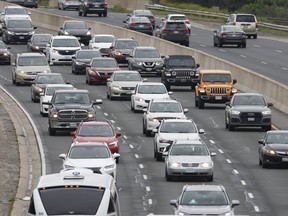
Article content
For decades, Ontario has underbuilt transportation infrastructure needed to get people and goods moving in the region spanning from Niagara to Oshawa to Barrie, and everywhere in between.
Advertisement 2
Article content
The argument is often polarized into a roads versus transit debate, resulting in far more debate than building, to the detriment of people and businesses alike. This needs to change.
The honest answer is Ontario needs both more highways and transit, and that is why the long-term transportation plan for the Greater Golden Horseshoe (GGH) released by the province last week is a crucial step forward for transportation infrastructure in Ontario.
plan, Connecting the GGH: A Transportation Plan for the Greater Golden Horseshoebrings a much-needed long-term focus to transportation planning that will serve us all.
Crucially, the vision put forth by Premier Doug Ford and Minister Caroline Mulroney offers a blend of sustained expansion of highway and transit infrastructure that will make it easier to get around the entire region, for all kinds of trips. This comprehensive vision for transportation throughout the GGH will alleviate gridlock within the city and create more options to move about the region where current capacity is lacking. This will shorten travel times, whether a vehicle on a highway or people on transit.
advertisement 3
Article content
Most importantly, it will expand travel options that do not force travelers through the center of Toronto, which is currently far too often the case. Shifting away from the hub-and-spoke model will create a smoother, integrated transportation experience throughout the broader region by creating capacity where it is needed.
Beyond simply looking at transportation, it creates favorable conditions for greater densification throughout the region. The kind that facilitates a significant addition of desperately needed housing supply and clearing the way for more jobs, with greater proximity for people to those employment opportunities.
The cost of inaction is real. The gridlock the region experiences today already comes with significant economic costs — $11 billion per year in lost productivity and very real impacts on quality of life for residents. Long commutes cause strain on families, add stresses to daily life, and robs too many of life’s most precious commodity, time.
advertisement 4
Article content
By 2051, population figures in the GGH are forecast to grow from 10 million to 14.9 million people. Without sustained investment and focus on expanding critical transportation and transit infrastructure, today’s gridlock will feel like the golden years of yore in comparison.
The integrated approach to planning offers many benefits.
Take the proposed Highway 413 for example, it will connect communities in the northwest GTA and provide a critical new transportation corridor where 80% of people currently commute by car, whether gas or electric. It, however, will not just be a new highway, the corridor will facilitate new transit development, in the form of a parallel transitway, to service the current residents in York, Halton, and Peel regions along its route and the 1.6 million new people projected to come to that part of the GTA.
advertisement 5
Article content
The transitway would run alongside the Highway 413 and be dedicated exclusively for public transit, such as buses and light rail. This is the sort of forward-thinking mix of transit and transportation infrastructure that the province needs.
This complimentary mix is why the long-term plan is visionary, as well as offering a proactive and predictable framework for industry and labor to build the future of Ontario that can meet the needs of the province for decades to come.
The province recognizes that this comprehensive planning document will evolve over time. That’s true of all long-term plans. One thing however will remain the same, Ontario needs a lot more transportation capacity to keep a growing region moving and addressing the problems of the past. Let’s get building.
— Nadia Todorova is the executive director of the Residential and Civil Construction Alliance of Ontario rccao.com